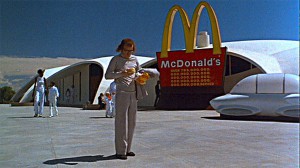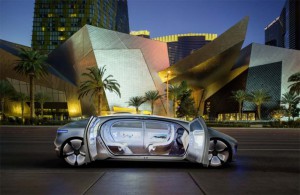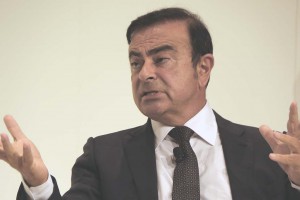In the 1973 film, “Sleeper,” Woody Allen is revived after being frozen following a botched operation. To escape the inept police state trying to terminate him, he steals a car that looks like a bubble, with frosted windows and no steering wheel. He simply tells it where to go.
The comedy was supposed to take place 200 years from now but, at least when it comes to the car, it could just as well happen in little more than a decade from now. A recent concept vehicle from Mercedes-Benz, the F 015, can black out its windows, use voice commands to safely drive automatically to a destination, and passengers can swivel their seats to turn the big sedan into a mobile living room.
At least, that’s the grand vision – but it’s creating nightmares for an auto industry facing tough new mileage, emissions and safety regulations and the need to invest tens of billions of dollars in new and largely untested technologies. And traditional automakers face the threat of new and well-funded challengers, such as Tesla, Google and Apple.
“We all have a challenge now, the whole industry, imagining what the car will be like five or 10 years down the road,” said Carlos Ghosn, the CEO of the Renault/Nissan Alliance, during a roundtable discussion at the Frankfurt Motor Show earlier this week.
(Click Here for a complete round-up from the 2015 Frankfurt Motor Show.)
There are a lot of things, he stressed, that will be “disrupters,” transforming the familiar, gas-powered, human-operated automobile into something out of a science fiction film.
The challenges are many, but key among them are:
- The need to slash emissions of traditional pollutants, as well as global warming CO2 gases;
- Demands to radically increase fuel economy, the U.S. setting a 54.5 mpg target for 2025, and Europe pushing even higher;
- Ever-stricter safety mandates, even some automakers now setting a goal of reaching a point where no one will be killed in a car crash; and
- A push to solve worsening urban traffic problems, a situation getting worse by the day as more of the world’s population moves to megacities.
In years past, simply addressing one of those issues would have been a daunting challenge. Resolving them all threatens to overwhelm even the largest and richest automakers. It’s one reason why Sergio Marchionne, the CEO of Fiat Chrysler Automobiles, has said there must be major consolidation within the auto industry – and why he has been pressing General Motors for a merger of the two companies.
(Global survey finds few folks ready to walk away from their cars. Click Here for more.)
Renault and Nissan linked up nearly two decades ago and more recently entered into a partnership with Germany’s Daimler AG, the maker of Mercedes and Smart products. Together, they have already launched about 30 joint ventures aimed at reducing costs and pushing new technologies to market faster. That includes battery-car and hydrogen fuel-cell vehicle projects, and they may soon work together on autonomous vehicle technology where they’ve separately been pressing for leadership.
Alternative powertrain technology is one of the areas where manufacturers are likely to face the biggest challenges, and where they’re most likely to work together. Developing even a conventional gasoline engine can be a billion dollar project. Coming up with high-mileage, low-emissions alternatives will cost far more, analysts warn.
Autonomous vehicle could prove equally daunting, and as Google has learned with its own, industry-leading program, there are plenty of potential potholes. The maker’s self-driving prototypes have been involved in more than a dozen crashes, in part because they were programmed to strictly obey the law. But jamming on the brakes when the light turns yellow risks your being rammed by the car behind, driven by a human hoping to save time by running the light.
“This will not be a boring, commodity business,” said Ghosn, but one rapidly evolving.
Automakers aren’t the only ones who will be challenged, however. Tomorrow’s cars will be more expensive and more complex. Simply fueling – or charging – them up could become a very different process.
Even today’s latest models have become technological showcases, with more computer power than the typical home or office. But trying to figure out how to use everything can be overwhelming. Research by J.D. Power and Associates has found that in-car technology is the single-largest source of “problems” with new cars.
With new features such as gesture controls and the ability to automatically park itself in a garage after the driver exits the vehicle, the new 2016 BMW 750i could be too much for less tech-savvy buyers. So, the Bavarian maker has launched the Encore program. A specially trained dealer rep will visit the buyer’s home or office after a couple weeks to answer questions and show off the new features.
Meanwhile, government will also need to play a role. If regulators mandate cleaner cars, automakers say federal, state and local officials need to come up with the money for high-speed battery chargers and hydrogen fueling stations. They may also need to set aside special highway lanes for autonomous vehicles, much like today’s commuter lanes.
A lot of things will have to come together in surprisingly short order if we’re going to put those clean, fuel-efficient and safe bubble cars on the road in the next decade, rather than waiting a couple centuries.
(VW, Audi plan to “electrify” every car they sell. Click Here for more.)





No the government, aka “tax payers” should NOT come up with the money for EV battery chargers nor hydrogen refilling stations. If there is a legitimate need, free enterprise will fill it just as they do with gas, Diesel, CNG and propane for motor vehicles.
If the auto makers want to sell impractical EVs to meet outrageous mpg mandates by the criminals in DC, then the auto companies are the ones who need to build the supporting infrastructure in cooperation with utility companies or other vested interest parties. You can be certain that if there was any money to be made in providing battery charging stations that the utility companies would be in control of them.
Does BMW really think people in the U.S. who refuse to read their new vehicle owner’s manual, will actually remember whatever a dealer rep tells them regarding operation of the electronic distractions in a modern vehicle? Really? I have a million dollars that says there will be many more liability lawsuits in the U.S. in coming years with increased tech in cars and of course with all AVs when they arrive.
In the U.S. judicial system there is no such thing as personal responsibility except for manufacturers. According to the paid liars, auto makers should be held responsible for the irresponsible, irrational decisions of dangerous and negligent consumers who lack the skills and good judgment to properly and safely operate a motorized vehicle.